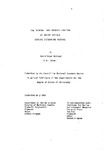THE REMOVAL AND REMOBILISATION OF HEAVY METALS DURING ESTUARINE MIXING
| dc.contributor.author | Ackroyd, David Roger | |
| dc.contributor.other | School of Biological and Marine Sciences | en_US |
| dc.date.accessioned | 2013-09-16T10:02:43Z | |
| dc.date.available | 2013-09-16T10:02:43Z | |
| dc.date.issued | 1983 | |
| dc.identifier | NOT AVAILABLE | en_US |
| dc.identifier.uri | http://hdl.handle.net/10026.1/1736 | |
| dc.description.abstract |
Elemental analyses have been made of dissolved, suspended particulate and sedimentary Cu, Mn, Zn following axial surveys of the Tamar Estuary. Continuous monitoring of the estuarine master variables was made during each survey. Selective digestion methods were applied to the particulate and sediment samples to determine the detrital and non-detrital fractions. These experiments showed that in general about 80-100% Mn, 60% Zn and 20% Cu were in the non-detrital form. Rank order correlation tests of the sediment results showed that the summer profiles were consistently different to 20 randomly generated profiles of the same data. In contrast the winter distribution showed a greater tendency to randomness which was related to the high energy resuspension processes dominant during that period. This temporal variation in sediment metal content has been interpreted in terms of a seasonal sediment accretion-erosion cycle observed in the estuary. The axial profiles of dissolved Zn and Mn often showed similar trends with a minimum concentration in the freshwater above the salt-wedge and a mid-estuarine maximum. A statistical analysis of the data using F-ratio tables, which also took into account variations in both salinity and'turbidity, showed that the relationship between Zn and Mn was in agreement with the hypothesis that the two elements are responsive to similar sorption processes in estuaries. Copper was rarely correlated with either Mn or Zn under the same reaction conditions, which suggested a different estuarine geochemistry. The dissolved, suspended particulate and sediment data for the three metals were then used to develop a two-box model of the Tamar Estuary. The seasonal transfer of Cu, Mn and Zn was then determined using the model. In general the overall mass transport followed the sequence Mn > Zn > Cu, with large transfers of material from the upper to lower estuary occurring in winter. The model was of use in predicting the fate of metals input from the mineralised catchment area feeding the Tamar Estuary. | en_US |
| dc.description.sponsorship | Institute for Marine Environmental Research, Prospect Place, The Hoe, Plymouth, Devon | en_US |
| dc.language.iso | en | en_US |
| dc.publisher | University of Plymouth | en_US |
| dc.title | THE REMOVAL AND REMOBILISATION OF HEAVY METALS DURING ESTUARINE MIXING | en_US |
| dc.type | Thesis | |
| plymouth.version | Full version | en_US |
| dc.identifier.doi | http://dx.doi.org/10.24382/3616 | |
| dc.identifier.doi | http://dx.doi.org/10.24382/3616 |
Files in this item
This item appears in the following Collection(s)
-
01 Research Theses Main Collection
Research Theses Main


